Analysing Organisational Restructure at ETI: Factors and Impacts
VerifiedAdded on 2020/10/23
|12
|2438
|396
Report
AI Summary
This report examines the organisational restructure of an Education and Training Institute (ETI), focusing on the factors that influenced the decision, the challenges encountered during the process, and the uncertainties arising from external factors. The report analyzes the impact of organisational culture changes on ETI's performance, highlighting the shift towards a bureaucratic structure and its effects on employee engagement and motivation. It also identifies conflicts and miscommunication stemming from centralised decision-making and unclear roles. The report provides recommendations for improving collaboration between individuals and groups, suggesting the use of models like McKinsey 7S and Tuckman's team building model to mitigate the negative impacts of the restructure and enhance overall organisational performance. The study concludes that proactive management of change is crucial for minimising adverse effects and fostering a more effective and adaptable organisational structure.
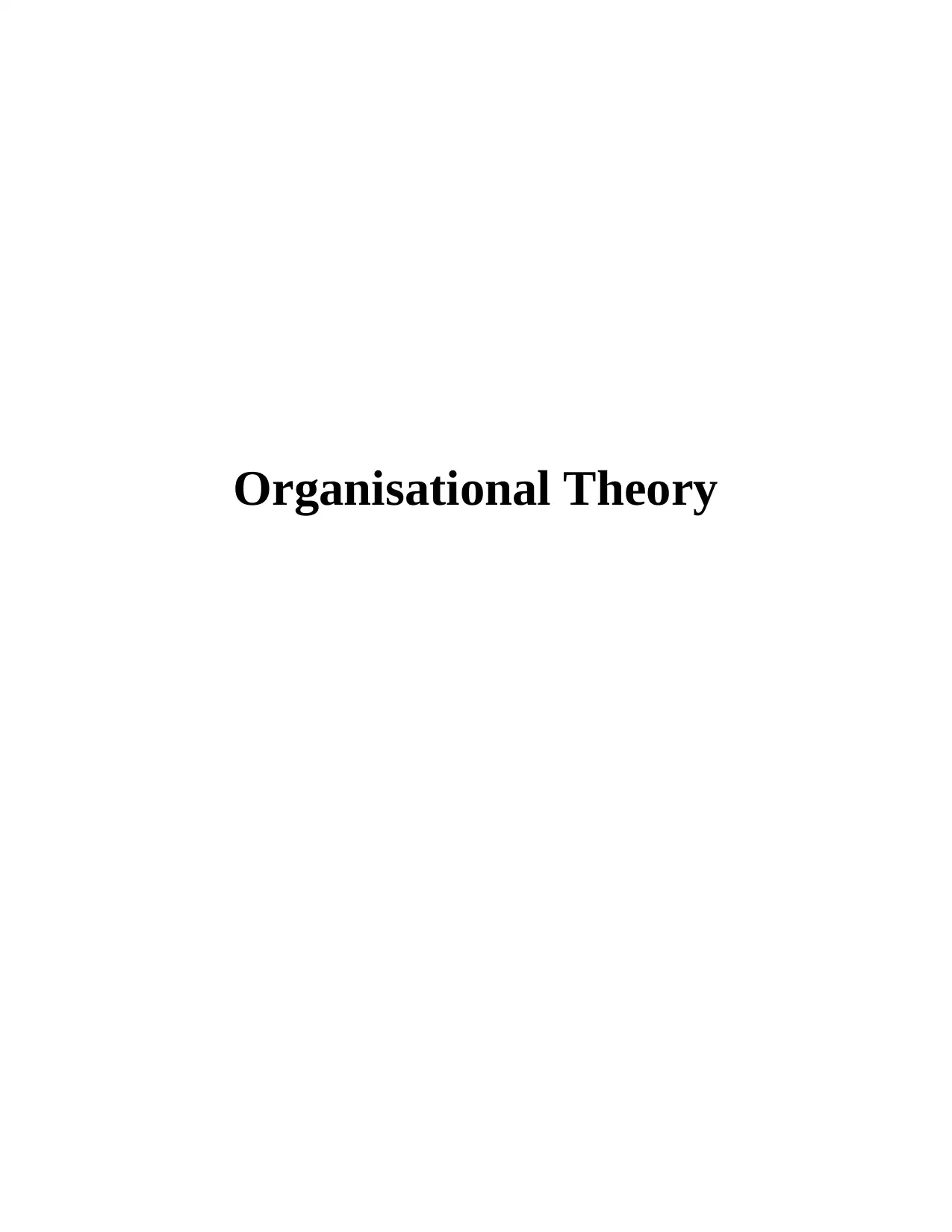
Organisational Theory
Paraphrase This Document
Need a fresh take? Get an instant paraphrase of this document with our AI Paraphraser
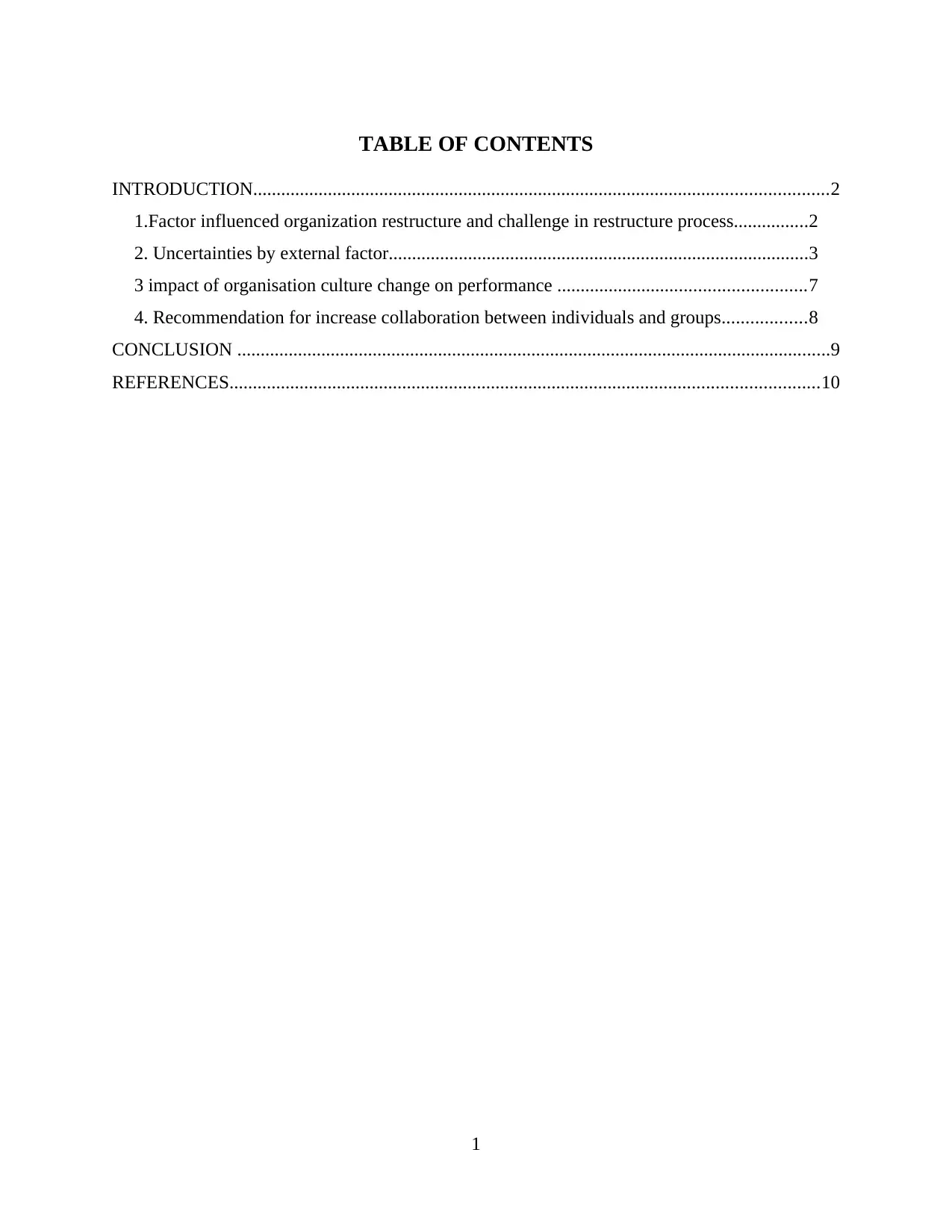
TABLE OF CONTENTS
INTRODUCTION...........................................................................................................................2
1.Factor influenced organization restructure and challenge in restructure process................2
2. Uncertainties by external factor..........................................................................................3
3 impact of organisation culture change on performance .....................................................7
4. Recommendation for increase collaboration between individuals and groups..................8
CONCLUSION ...............................................................................................................................9
REFERENCES..............................................................................................................................10
1
INTRODUCTION...........................................................................................................................2
1.Factor influenced organization restructure and challenge in restructure process................2
2. Uncertainties by external factor..........................................................................................3
3 impact of organisation culture change on performance .....................................................7
4. Recommendation for increase collaboration between individuals and groups..................8
CONCLUSION ...............................................................................................................................9
REFERENCES..............................................................................................................................10
1
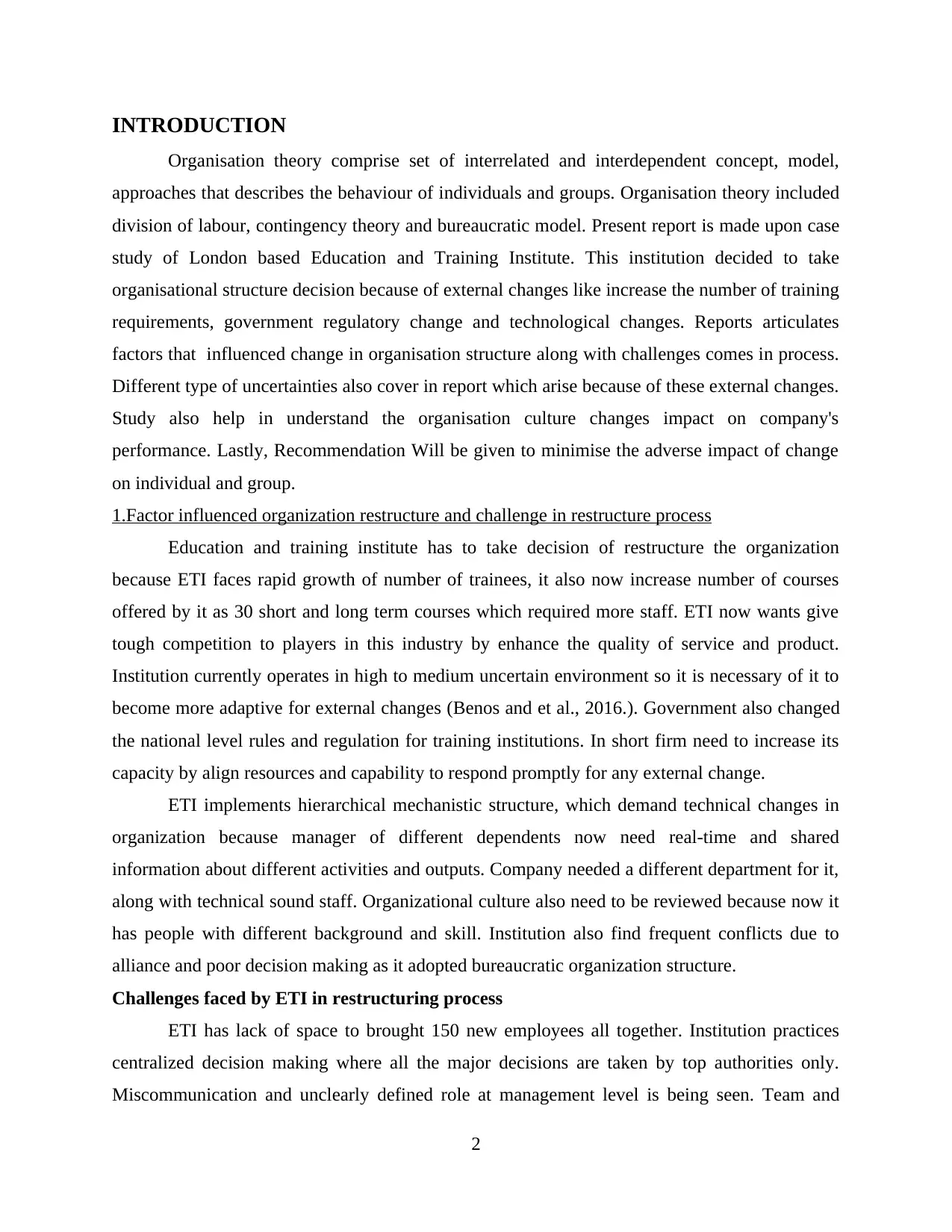
INTRODUCTION
Organisation theory comprise set of interrelated and interdependent concept, model,
approaches that describes the behaviour of individuals and groups. Organisation theory included
division of labour, contingency theory and bureaucratic model. Present report is made upon case
study of London based Education and Training Institute. This institution decided to take
organisational structure decision because of external changes like increase the number of training
requirements, government regulatory change and technological changes. Reports articulates
factors that influenced change in organisation structure along with challenges comes in process.
Different type of uncertainties also cover in report which arise because of these external changes.
Study also help in understand the organisation culture changes impact on company's
performance. Lastly, Recommendation Will be given to minimise the adverse impact of change
on individual and group.
1.Factor influenced organization restructure and challenge in restructure process
Education and training institute has to take decision of restructure the organization
because ETI faces rapid growth of number of trainees, it also now increase number of courses
offered by it as 30 short and long term courses which required more staff. ETI now wants give
tough competition to players in this industry by enhance the quality of service and product.
Institution currently operates in high to medium uncertain environment so it is necessary of it to
become more adaptive for external changes (Benos and et al., 2016.). Government also changed
the national level rules and regulation for training institutions. In short firm need to increase its
capacity by align resources and capability to respond promptly for any external change.
ETI implements hierarchical mechanistic structure, which demand technical changes in
organization because manager of different dependents now need real-time and shared
information about different activities and outputs. Company needed a different department for it,
along with technical sound staff. Organizational culture also need to be reviewed because now it
has people with different background and skill. Institution also find frequent conflicts due to
alliance and poor decision making as it adopted bureaucratic organization structure.
Challenges faced by ETI in restructuring process
ETI has lack of space to brought 150 new employees all together. Institution practices
centralized decision making where all the major decisions are taken by top authorities only.
Miscommunication and unclearly defined role at management level is being seen. Team and
2
Organisation theory comprise set of interrelated and interdependent concept, model,
approaches that describes the behaviour of individuals and groups. Organisation theory included
division of labour, contingency theory and bureaucratic model. Present report is made upon case
study of London based Education and Training Institute. This institution decided to take
organisational structure decision because of external changes like increase the number of training
requirements, government regulatory change and technological changes. Reports articulates
factors that influenced change in organisation structure along with challenges comes in process.
Different type of uncertainties also cover in report which arise because of these external changes.
Study also help in understand the organisation culture changes impact on company's
performance. Lastly, Recommendation Will be given to minimise the adverse impact of change
on individual and group.
1.Factor influenced organization restructure and challenge in restructure process
Education and training institute has to take decision of restructure the organization
because ETI faces rapid growth of number of trainees, it also now increase number of courses
offered by it as 30 short and long term courses which required more staff. ETI now wants give
tough competition to players in this industry by enhance the quality of service and product.
Institution currently operates in high to medium uncertain environment so it is necessary of it to
become more adaptive for external changes (Benos and et al., 2016.). Government also changed
the national level rules and regulation for training institutions. In short firm need to increase its
capacity by align resources and capability to respond promptly for any external change.
ETI implements hierarchical mechanistic structure, which demand technical changes in
organization because manager of different dependents now need real-time and shared
information about different activities and outputs. Company needed a different department for it,
along with technical sound staff. Organizational culture also need to be reviewed because now it
has people with different background and skill. Institution also find frequent conflicts due to
alliance and poor decision making as it adopted bureaucratic organization structure.
Challenges faced by ETI in restructuring process
ETI has lack of space to brought 150 new employees all together. Institution practices
centralized decision making where all the major decisions are taken by top authorities only.
Miscommunication and unclearly defined role at management level is being seen. Team and
2
⊘ This is a preview!⊘
Do you want full access?
Subscribe today to unlock all pages.

Trusted by 1+ million students worldwide
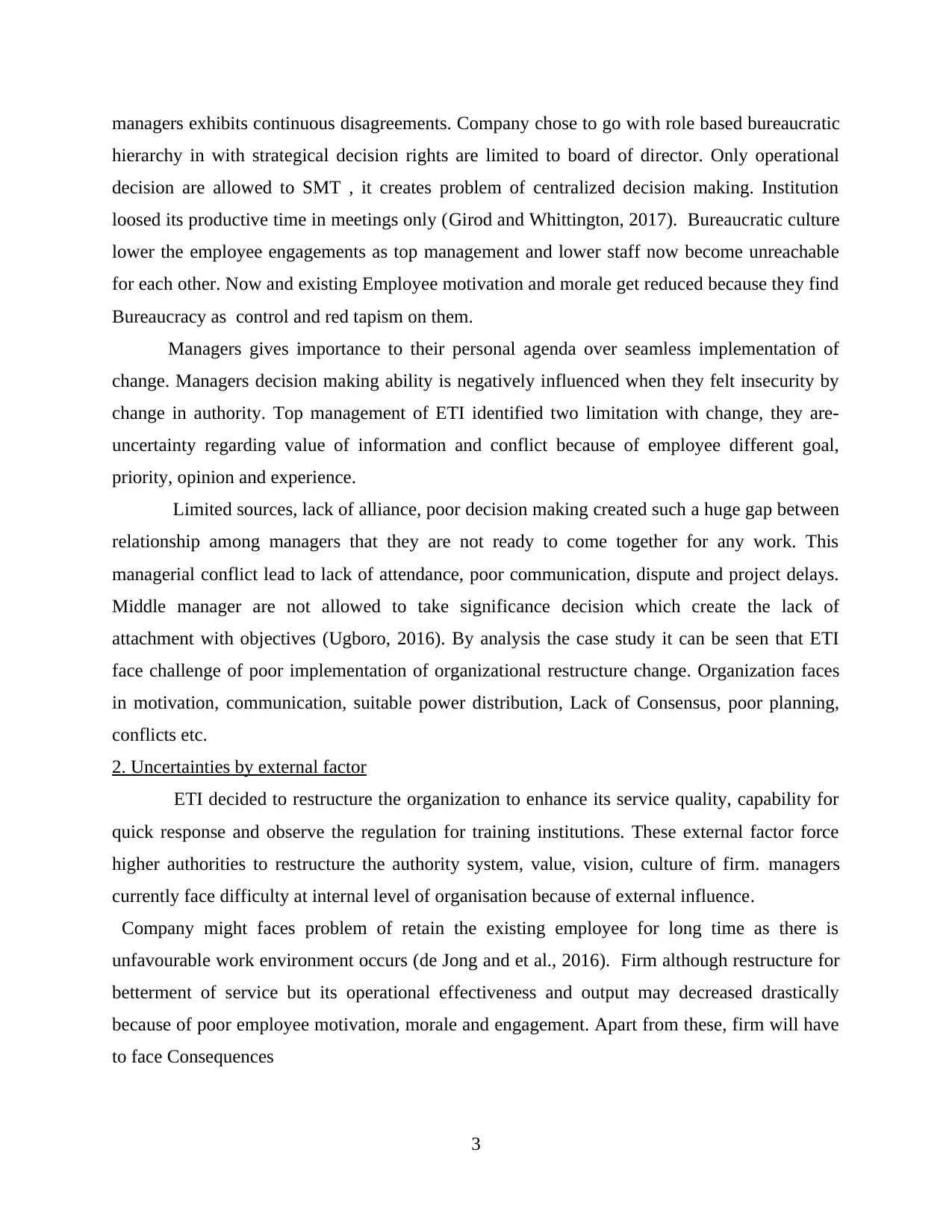
managers exhibits continuous disagreements. Company chose to go with role based bureaucratic
hierarchy in with strategical decision rights are limited to board of director. Only operational
decision are allowed to SMT , it creates problem of centralized decision making. Institution
loosed its productive time in meetings only (Girod and Whittington, 2017). Bureaucratic culture
lower the employee engagements as top management and lower staff now become unreachable
for each other. Now and existing Employee motivation and morale get reduced because they find
Bureaucracy as control and red tapism on them.
Managers gives importance to their personal agenda over seamless implementation of
change. Managers decision making ability is negatively influenced when they felt insecurity by
change in authority. Top management of ETI identified two limitation with change, they are-
uncertainty regarding value of information and conflict because of employee different goal,
priority, opinion and experience.
Limited sources, lack of alliance, poor decision making created such a huge gap between
relationship among managers that they are not ready to come together for any work. This
managerial conflict lead to lack of attendance, poor communication, dispute and project delays.
Middle manager are not allowed to take significance decision which create the lack of
attachment with objectives (Ugboro, 2016). By analysis the case study it can be seen that ETI
face challenge of poor implementation of organizational restructure change. Organization faces
in motivation, communication, suitable power distribution, Lack of Consensus, poor planning,
conflicts etc.
2. Uncertainties by external factor
ETI decided to restructure the organization to enhance its service quality, capability for
quick response and observe the regulation for training institutions. These external factor force
higher authorities to restructure the authority system, value, vision, culture of firm. managers
currently face difficulty at internal level of organisation because of external influence.
Company might faces problem of retain the existing employee for long time as there is
unfavourable work environment occurs (de Jong and et al., 2016). Firm although restructure for
betterment of service but its operational effectiveness and output may decreased drastically
because of poor employee motivation, morale and engagement. Apart from these, firm will have
to face Consequences
3
hierarchy in with strategical decision rights are limited to board of director. Only operational
decision are allowed to SMT , it creates problem of centralized decision making. Institution
loosed its productive time in meetings only (Girod and Whittington, 2017). Bureaucratic culture
lower the employee engagements as top management and lower staff now become unreachable
for each other. Now and existing Employee motivation and morale get reduced because they find
Bureaucracy as control and red tapism on them.
Managers gives importance to their personal agenda over seamless implementation of
change. Managers decision making ability is negatively influenced when they felt insecurity by
change in authority. Top management of ETI identified two limitation with change, they are-
uncertainty regarding value of information and conflict because of employee different goal,
priority, opinion and experience.
Limited sources, lack of alliance, poor decision making created such a huge gap between
relationship among managers that they are not ready to come together for any work. This
managerial conflict lead to lack of attendance, poor communication, dispute and project delays.
Middle manager are not allowed to take significance decision which create the lack of
attachment with objectives (Ugboro, 2016). By analysis the case study it can be seen that ETI
face challenge of poor implementation of organizational restructure change. Organization faces
in motivation, communication, suitable power distribution, Lack of Consensus, poor planning,
conflicts etc.
2. Uncertainties by external factor
ETI decided to restructure the organization to enhance its service quality, capability for
quick response and observe the regulation for training institutions. These external factor force
higher authorities to restructure the authority system, value, vision, culture of firm. managers
currently face difficulty at internal level of organisation because of external influence.
Company might faces problem of retain the existing employee for long time as there is
unfavourable work environment occurs (de Jong and et al., 2016). Firm although restructure for
betterment of service but its operational effectiveness and output may decreased drastically
because of poor employee motivation, morale and engagement. Apart from these, firm will have
to face Consequences
3
Paraphrase This Document
Need a fresh take? Get an instant paraphrase of this document with our AI Paraphraser

of poor decision making like missed deadlines, wastage, time and cost associate with these
decision. Company can also lose its customer because teams company went with centralized
authority, where manager has to take permission for every change from boss. Lack of decision
taking autonomy limits operational manager to handle customer more effectively.
Company also decide to make different department but their respective manager has
limited power, it would hardly render the best result as expected by top management. Frequent
conflicts lead to poor productivity, ill mental health, poor interpersonal relation, high employee
turnover ratio etc. ETI 's goodwill and reputation would impact when its employee leave the
organisation and create bad word of mouth marketing for its policity, system and employee
management (Spencer, 2018). HR department will to have difficulty to attract the best talent
from market to work with them. There are more chances of conflicts and bad utilisation of
resources as people mare not clear about their role and responsibility.
Value of information is referred to willingness of decision maker to give information
before making the actual decision. In given case study firm identifies uncertainty of value of
information which means it is all up to top management “ how much and what kind of
information they are giving to SMT managers. Top management give importance to their
personal objective so, there is high chances that they will give incomplete, wrong, and late
information to SML. It can hamper the service quality as well as accuracy of decisions.
Recommendation
McKinsey 7S Change Model can helps to deal with this problem, because it comprised
every elements ETI needs immediate rectification.
Structure-
it seems totally impractical decision to choose centralised organisation structure in this
business era. ETI should go with more liberalised or decentralized because SMT managers now
have to handle at least 300% more human capital than earlier, in such case if they have to go to
senior person for everything, it would become more hectic work for them.
4
decision. Company can also lose its customer because teams company went with centralized
authority, where manager has to take permission for every change from boss. Lack of decision
taking autonomy limits operational manager to handle customer more effectively.
Company also decide to make different department but their respective manager has
limited power, it would hardly render the best result as expected by top management. Frequent
conflicts lead to poor productivity, ill mental health, poor interpersonal relation, high employee
turnover ratio etc. ETI 's goodwill and reputation would impact when its employee leave the
organisation and create bad word of mouth marketing for its policity, system and employee
management (Spencer, 2018). HR department will to have difficulty to attract the best talent
from market to work with them. There are more chances of conflicts and bad utilisation of
resources as people mare not clear about their role and responsibility.
Value of information is referred to willingness of decision maker to give information
before making the actual decision. In given case study firm identifies uncertainty of value of
information which means it is all up to top management “ how much and what kind of
information they are giving to SMT managers. Top management give importance to their
personal objective so, there is high chances that they will give incomplete, wrong, and late
information to SML. It can hamper the service quality as well as accuracy of decisions.
Recommendation
McKinsey 7S Change Model can helps to deal with this problem, because it comprised
every elements ETI needs immediate rectification.
Structure-
it seems totally impractical decision to choose centralised organisation structure in this
business era. ETI should go with more liberalised or decentralized because SMT managers now
have to handle at least 300% more human capital than earlier, in such case if they have to go to
senior person for everything, it would become more hectic work for them.
4

5
Illustration 1: McKinsey 7S Model
(McKinsey 7S Model, 2011)
Illustration 1: McKinsey 7S Model
(McKinsey 7S Model, 2011)
⊘ This is a preview!⊘
Do you want full access?
Subscribe today to unlock all pages.

Trusted by 1+ million students worldwide

Staff
staff members should have clarity about their role and responsibilities. Middle managerial
staff should be allow in making agreed objective so that their interest and organisational goal
will not go in different direction. Not only new people should be equipped with training and
development for technological adaption but also existing people should receive T&D as well.
Style
Old staff member are eligible for delegation leadership where new people are subject to
autocratic leaderships because they are not aware about organisation culture, lack of experience
etc.
System
ETI should implement all the essential change adhere by national standards moreover
there is urgent requirement to go with informal communication to minimise the meeting time.
Value based leader is recommendatory to implement in company because it works upon build
trust among diverse people (Ravanfar, 2015).
Skills
middle managerial staff as well as lower people need urgent need of training and
development on interpersonal relationship. Manager should have access to require information
on time, it will enhance their capabilities.
Shared Value
Top managers though tried to achieve co-lobative culture in value but bureaucratic
culture hinder the desired outcome, which can be only solve when higher authority and lower
one can directly talk to each other.
Strategy
company should conflict management strategy like Accommodating, avoiding,
Collaborating, Compromising and Competing.
6
staff members should have clarity about their role and responsibilities. Middle managerial
staff should be allow in making agreed objective so that their interest and organisational goal
will not go in different direction. Not only new people should be equipped with training and
development for technological adaption but also existing people should receive T&D as well.
Style
Old staff member are eligible for delegation leadership where new people are subject to
autocratic leaderships because they are not aware about organisation culture, lack of experience
etc.
System
ETI should implement all the essential change adhere by national standards moreover
there is urgent requirement to go with informal communication to minimise the meeting time.
Value based leader is recommendatory to implement in company because it works upon build
trust among diverse people (Ravanfar, 2015).
Skills
middle managerial staff as well as lower people need urgent need of training and
development on interpersonal relationship. Manager should have access to require information
on time, it will enhance their capabilities.
Shared Value
Top managers though tried to achieve co-lobative culture in value but bureaucratic
culture hinder the desired outcome, which can be only solve when higher authority and lower
one can directly talk to each other.
Strategy
company should conflict management strategy like Accommodating, avoiding,
Collaborating, Compromising and Competing.
6
Paraphrase This Document
Need a fresh take? Get an instant paraphrase of this document with our AI Paraphraser
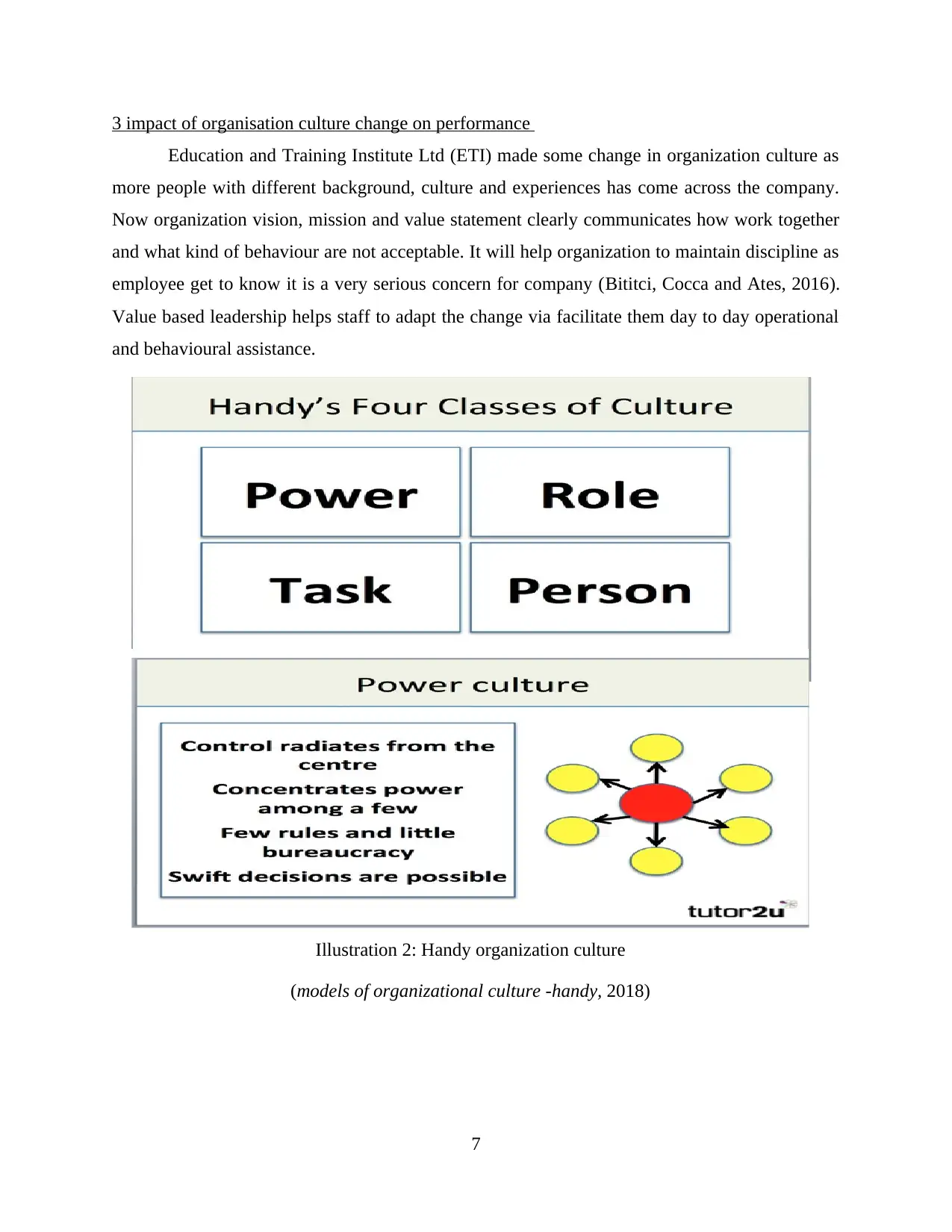
3 impact of organisation culture change on performance
Education and Training Institute Ltd (ETI) made some change in organization culture as
more people with different background, culture and experiences has come across the company.
Now organization vision, mission and value statement clearly communicates how work together
and what kind of behaviour are not acceptable. It will help organization to maintain discipline as
employee get to know it is a very serious concern for company (Bititci, Cocca and Ates, 2016).
Value based leadership helps staff to adapt the change via facilitate them day to day operational
and behavioural assistance.
7
Illustration 2: Handy organization culture
(models of organizational culture -handy, 2018)
Education and Training Institute Ltd (ETI) made some change in organization culture as
more people with different background, culture and experiences has come across the company.
Now organization vision, mission and value statement clearly communicates how work together
and what kind of behaviour are not acceptable. It will help organization to maintain discipline as
employee get to know it is a very serious concern for company (Bititci, Cocca and Ates, 2016).
Value based leadership helps staff to adapt the change via facilitate them day to day operational
and behavioural assistance.
7
Illustration 2: Handy organization culture
(models of organizational culture -handy, 2018)
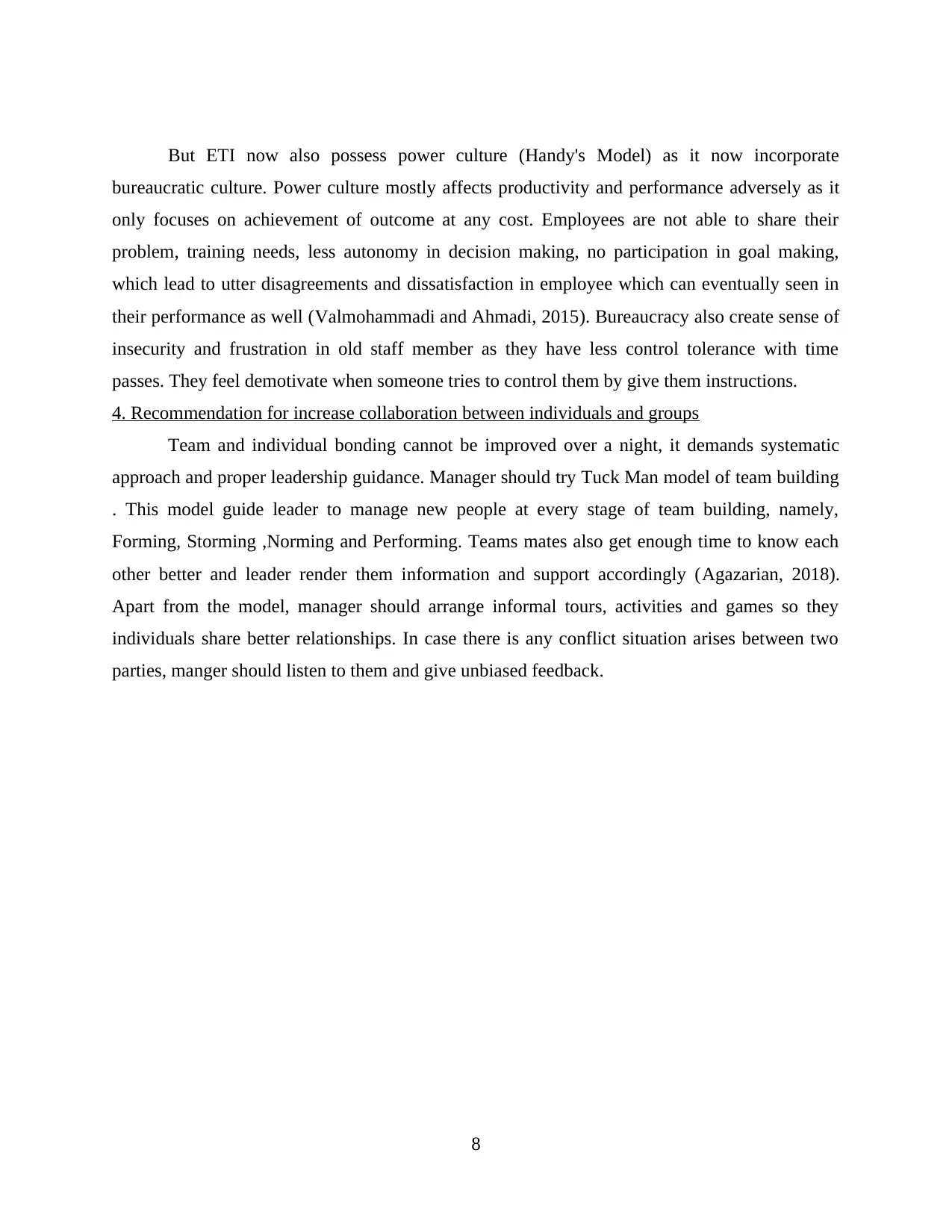
But ETI now also possess power culture (Handy's Model) as it now incorporate
bureaucratic culture. Power culture mostly affects productivity and performance adversely as it
only focuses on achievement of outcome at any cost. Employees are not able to share their
problem, training needs, less autonomy in decision making, no participation in goal making,
which lead to utter disagreements and dissatisfaction in employee which can eventually seen in
their performance as well (Valmohammadi and Ahmadi, 2015). Bureaucracy also create sense of
insecurity and frustration in old staff member as they have less control tolerance with time
passes. They feel demotivate when someone tries to control them by give them instructions.
4. Recommendation for increase collaboration between individuals and groups
Team and individual bonding cannot be improved over a night, it demands systematic
approach and proper leadership guidance. Manager should try Tuck Man model of team building
. This model guide leader to manage new people at every stage of team building, namely,
Forming, Storming ,Norming and Performing. Teams mates also get enough time to know each
other better and leader render them information and support accordingly (Agazarian, 2018).
Apart from the model, manager should arrange informal tours, activities and games so they
individuals share better relationships. In case there is any conflict situation arises between two
parties, manger should listen to them and give unbiased feedback.
8
bureaucratic culture. Power culture mostly affects productivity and performance adversely as it
only focuses on achievement of outcome at any cost. Employees are not able to share their
problem, training needs, less autonomy in decision making, no participation in goal making,
which lead to utter disagreements and dissatisfaction in employee which can eventually seen in
their performance as well (Valmohammadi and Ahmadi, 2015). Bureaucracy also create sense of
insecurity and frustration in old staff member as they have less control tolerance with time
passes. They feel demotivate when someone tries to control them by give them instructions.
4. Recommendation for increase collaboration between individuals and groups
Team and individual bonding cannot be improved over a night, it demands systematic
approach and proper leadership guidance. Manager should try Tuck Man model of team building
. This model guide leader to manage new people at every stage of team building, namely,
Forming, Storming ,Norming and Performing. Teams mates also get enough time to know each
other better and leader render them information and support accordingly (Agazarian, 2018).
Apart from the model, manager should arrange informal tours, activities and games so they
individuals share better relationships. In case there is any conflict situation arises between two
parties, manger should listen to them and give unbiased feedback.
8
⊘ This is a preview!⊘
Do you want full access?
Subscribe today to unlock all pages.

Trusted by 1+ million students worldwide
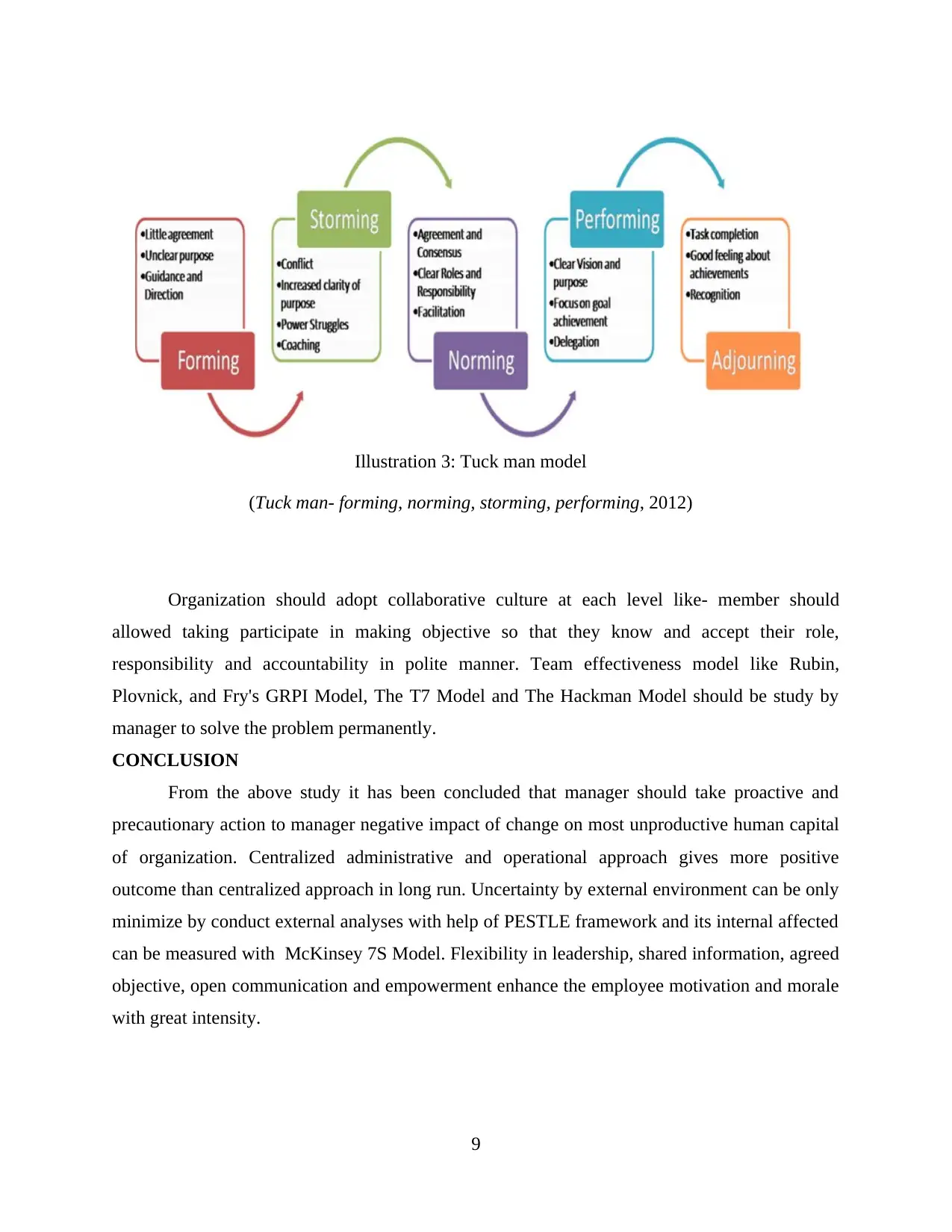
Organization should adopt collaborative culture at each level like- member should
allowed taking participate in making objective so that they know and accept their role,
responsibility and accountability in polite manner. Team effectiveness model like Rubin,
Plovnick, and Fry's GRPI Model, The T7 Model and The Hackman Model should be study by
manager to solve the problem permanently.
CONCLUSION
From the above study it has been concluded that manager should take proactive and
precautionary action to manager negative impact of change on most unproductive human capital
of organization. Centralized administrative and operational approach gives more positive
outcome than centralized approach in long run. Uncertainty by external environment can be only
minimize by conduct external analyses with help of PESTLE framework and its internal affected
can be measured with McKinsey 7S Model. Flexibility in leadership, shared information, agreed
objective, open communication and empowerment enhance the employee motivation and morale
with great intensity.
9
Illustration 3: Tuck man model
(Tuck man- forming, norming, storming, performing, 2012)
allowed taking participate in making objective so that they know and accept their role,
responsibility and accountability in polite manner. Team effectiveness model like Rubin,
Plovnick, and Fry's GRPI Model, The T7 Model and The Hackman Model should be study by
manager to solve the problem permanently.
CONCLUSION
From the above study it has been concluded that manager should take proactive and
precautionary action to manager negative impact of change on most unproductive human capital
of organization. Centralized administrative and operational approach gives more positive
outcome than centralized approach in long run. Uncertainty by external environment can be only
minimize by conduct external analyses with help of PESTLE framework and its internal affected
can be measured with McKinsey 7S Model. Flexibility in leadership, shared information, agreed
objective, open communication and empowerment enhance the employee motivation and morale
with great intensity.
9
Illustration 3: Tuck man model
(Tuck man- forming, norming, storming, performing, 2012)
Paraphrase This Document
Need a fresh take? Get an instant paraphrase of this document with our AI Paraphraser

REFERENCES
Books and Journals
Agazarian, Y. M., 2018. Group-as-a-whole systems theory and practice. In Systems-Centered
Practice (pp. 79-116). Routledge.
Benos, T and et al., 2016. Cooperatives’ organizational restructuring, strategic attributes, and
performance: The case of agribusiness cooperatives in Greece. Agribusiness. 32(1).
pp.127-150.
Bititci, U., Cocca, P. and Ates, A., 2016. Impact of visual performance management systems on
the performance management practices of organisations. International Journal of
Production Research. 54(6). pp.1571-1593.
de Jong, T and et al., 2016. The impact of restructuring on employee well-being: a systematic
review of longitudinal studies. Work & Stress. 30(1). pp.91-114.
Girod, S. J. and Whittington, R., 2017. Reconfiguration, restructuring and firm performance:
Dynamic capabilities and environmental dynamism. Strategic Management Journal. 38(5).
pp.1121-1133.
Ravanfar, M. M., 2015. Analyzing Organizational Structure based on 7s model of McKinsey.
Global Journal of Management And Business Research.
Spencer, M. S., 2018. Leadership Challenges Associated with Organizational Restructuring: A
Phenomenological Study (Doctoral dissertation, University of Phoenix).
Ugboro, I. O., 2016. Influence of managerial trust on survivors' perceptions of job insecurity and
organizational commitment in a post restructuring and downsizing environment. Journal of
Behavioral and Applied Management. 4(3). p.1077.
Valmohammadi, C. and Ahmadi, M., 2015. The impact of knowledge management practices on
organizational performance: A balanced scorecard approach. Journal of Enterprise
Information Management. 28(1). pp.131-159.
Online
McKinsey 7S Model. 2011. [Online]. Available through
<https://whittblog.wordpress.com/2011/04/24/mckinsey-7s-model-a-strategic-
assessment-and-alignment-model/ >
10
Books and Journals
Agazarian, Y. M., 2018. Group-as-a-whole systems theory and practice. In Systems-Centered
Practice (pp. 79-116). Routledge.
Benos, T and et al., 2016. Cooperatives’ organizational restructuring, strategic attributes, and
performance: The case of agribusiness cooperatives in Greece. Agribusiness. 32(1).
pp.127-150.
Bititci, U., Cocca, P. and Ates, A., 2016. Impact of visual performance management systems on
the performance management practices of organisations. International Journal of
Production Research. 54(6). pp.1571-1593.
de Jong, T and et al., 2016. The impact of restructuring on employee well-being: a systematic
review of longitudinal studies. Work & Stress. 30(1). pp.91-114.
Girod, S. J. and Whittington, R., 2017. Reconfiguration, restructuring and firm performance:
Dynamic capabilities and environmental dynamism. Strategic Management Journal. 38(5).
pp.1121-1133.
Ravanfar, M. M., 2015. Analyzing Organizational Structure based on 7s model of McKinsey.
Global Journal of Management And Business Research.
Spencer, M. S., 2018. Leadership Challenges Associated with Organizational Restructuring: A
Phenomenological Study (Doctoral dissertation, University of Phoenix).
Ugboro, I. O., 2016. Influence of managerial trust on survivors' perceptions of job insecurity and
organizational commitment in a post restructuring and downsizing environment. Journal of
Behavioral and Applied Management. 4(3). p.1077.
Valmohammadi, C. and Ahmadi, M., 2015. The impact of knowledge management practices on
organizational performance: A balanced scorecard approach. Journal of Enterprise
Information Management. 28(1). pp.131-159.
Online
McKinsey 7S Model. 2011. [Online]. Available through
<https://whittblog.wordpress.com/2011/04/24/mckinsey-7s-model-a-strategic-
assessment-and-alignment-model/ >
10
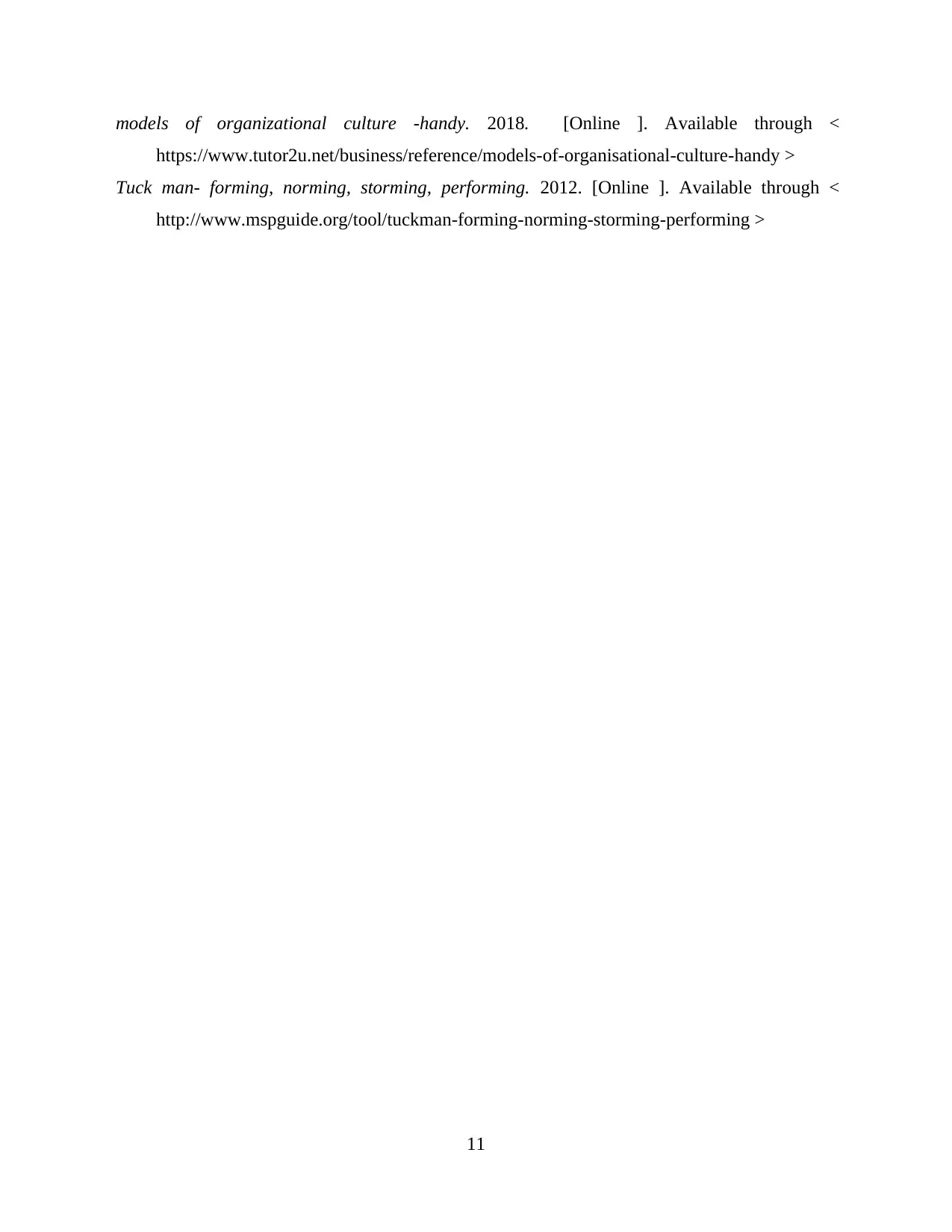
models of organizational culture -handy. 2018. [Online ]. Available through <
https://www.tutor2u.net/business/reference/models-of-organisational-culture-handy >
Tuck man- forming, norming, storming, performing. 2012. [Online ]. Available through <
http://www.mspguide.org/tool/tuckman-forming-norming-storming-performing >
11
https://www.tutor2u.net/business/reference/models-of-organisational-culture-handy >
Tuck man- forming, norming, storming, performing. 2012. [Online ]. Available through <
http://www.mspguide.org/tool/tuckman-forming-norming-storming-performing >
11
⊘ This is a preview!⊘
Do you want full access?
Subscribe today to unlock all pages.

Trusted by 1+ million students worldwide
1 out of 12
Related Documents
Your All-in-One AI-Powered Toolkit for Academic Success.
+13062052269
info@desklib.com
Available 24*7 on WhatsApp / Email
![[object Object]](/_next/static/media/star-bottom.7253800d.svg)
Unlock your academic potential
Copyright © 2020–2025 A2Z Services. All Rights Reserved. Developed and managed by ZUCOL.



